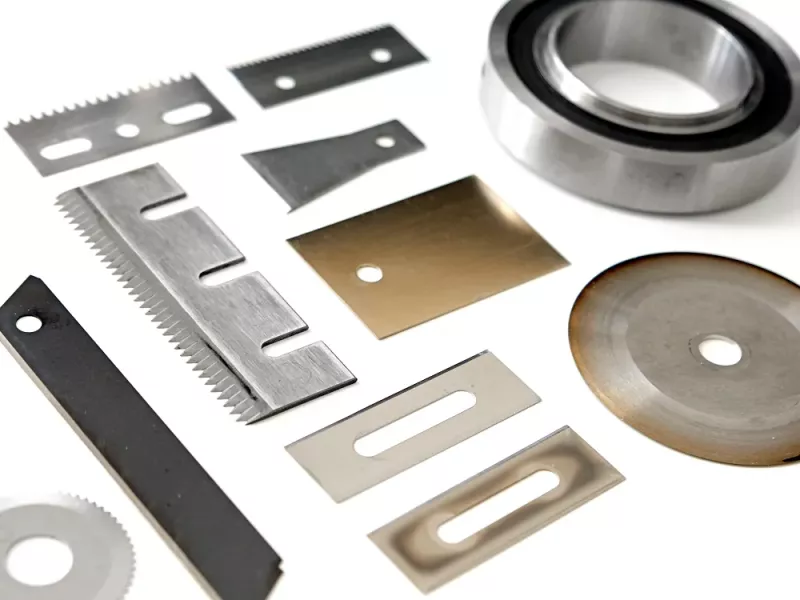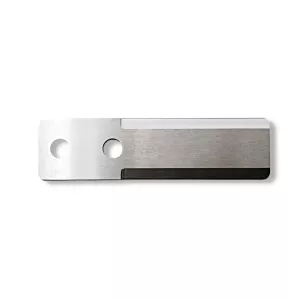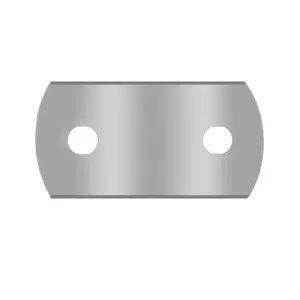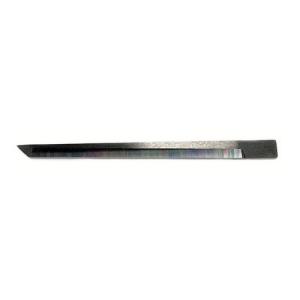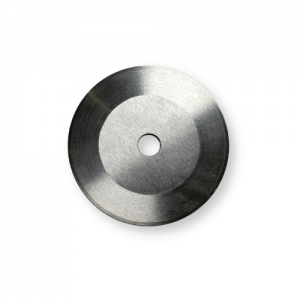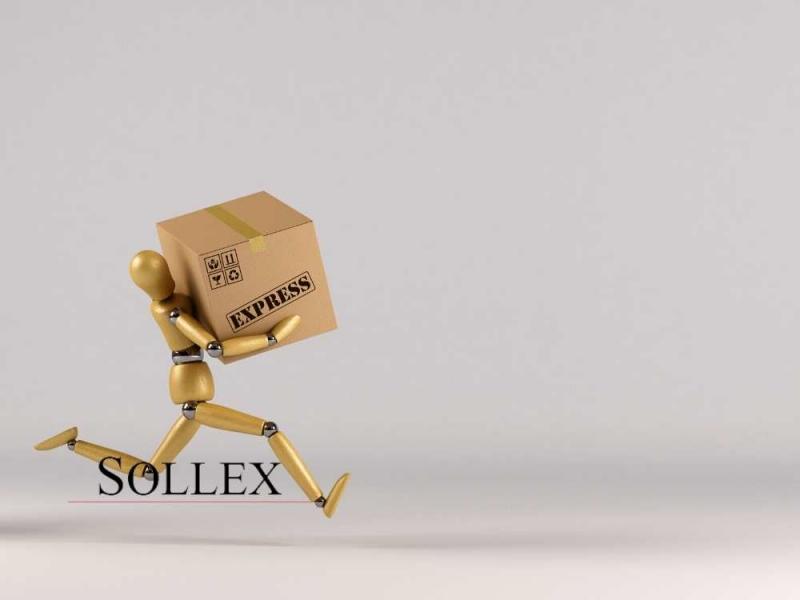Overview of Materials for Industrial Machine Knives
A detailed review on the materials used for the production of industrial machine knives and the criteria for choosing the right knife for your application
Industrial knives are used in a wide range of industries, including paper and pulp, packaging, food processing, plastics, and metalworking. These knives must be made from high-quality steel to withstand the demands of heavy use, maintain a sharp edge, and resist wear and corrosion.
Here are steel grades used for manufacturing industrial knives:
- Carbon Steel
- Stainless Steel
- Tool Steel
- Alloy Steel

There are also 2 composite materials that are used for machine knife manufacturing. They are not specific steel types, but composite materials:
- Tungsten Carbide
- Bi-Metal
In addition to the type of material used, the heat treatment and tempering process are essential factors in determining its hardness, toughness, and edge durability. Industrial knife manufacturers carefully select the steel and heat treatment process to create a blade that meets the specific demands of the intended application.
Industrial Knives and Blades in Carbon Steel
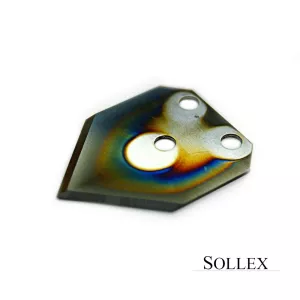 Carbon steel is a type of steel that contains primarily carbon, typically between 0.5% and 2% by weight, and small amounts of other elements, such as manganese, silicon, and sulfur. Carbon steel is known for its hardness, durability, and sharpness, making it a popular choice for industrial knives.
Carbon steel is a type of steel that contains primarily carbon, typically between 0.5% and 2% by weight, and small amounts of other elements, such as manganese, silicon, and sulfur. Carbon steel is known for its hardness, durability, and sharpness, making it a popular choice for industrial knives.
Industrial knives made from carbon steel offer excellent sharpness, durability, and wear resistance, making them ideal for use in cutting and slicing applications. However, carbon steel knives are more susceptible to rust and staining than stainless steel knives, and they may require more frequent maintenance to prevent corrosion. Carbon steel knives may also require more frequent sharpening than stainless steel knives due to their softer nature.
Here are some common types of carbon steel used for industrial knives:
- High Carbon Steel - High carbon steel contains a high percentage of carbon, typically between 0.6% and 1.4%. It's known for its exceptional hardness and edge retention, making it ideal for industrial knives. However, high carbon steel is susceptible to corrosion, making it essential to keep the blade dry and oiled to prevent rust.
- Medium Carbon Steel - Medium carbon steel contains between 0.3% and 0.6% carbon. It's known for its excellent toughness and wear resistance, making it ideal for heavy-duty applications, such as industrial knives and tools. However, it may not hold an edge as well as high carbon steel.
- Low Carbon Steel - Low carbon steel contains less than 0.3% carbon. It's easy to work with and has good weldability, making it ideal for applications that require shaping or forming, such as construction and automotive industries. However, low carbon steel is not as hard or durable as high carbon steel, making it less suitable for industrial knife applications.
In addition to carbon, other elements that can be found in carbon steel include:
- Manganese (Mn): Often added to carbon steel to improve its strength and toughness.
- Silicon (Si): Often added to carbon steel to improve its strength and hardness.
- Sulfur (S): A small amount of sulfur is often added to improve machinability, but too much sulfur can reduce the toughness of the material.
- Phosphorus (P): Often added to carbon steel to improve its strength and hardness, but too much phosphorus can make the material brittle.
Note that the specific composition of carbon steel can vary depending on the intended use and the desired properties of the material.
Carbon steel can be heat treated to achieve different levels of hardness and toughness, depending on the intended application. The most common heat treatment process for carbon steel is quenching and tempering, which involves heating the steel to a specific temperature and then rapidly cooling it in water or oil to harden the steel. The steel is then tempered, or reheated to a lower temperature, to reduce its brittleness and improve its toughness.
Sollex carbon steel industrial blades you can explore here
Industrial Machine Knives in Alloy Steels
Alloy steel is a type of steel that contains additional alloying elements in addition to carbon, typically between 1% and 50% of the total alloying elements by weight. The addition of alloying elements gives the steel enhanced properties, such as increased strength, hardness, toughness, and corrosion resistance, compared to carbon steel.
Here are some common alloying elements used in alloy steel and their properties:
- Chromium - Chromium is added to steel to increase its corrosion resistance and hardness. It forms a thin layer of oxide on the surface of the steel, known as the "passive layer," which protects the steel from further corrosion. Chromium is commonly used in stainless steel alloys.
- Molybdenum - Molybdenum is added to steel to increase its strength, toughness, and resistance to corrosion and wear. It's commonly used in high-strength low-alloy (HSLA) steels, which are used in heavy machinery and equipment.
- Nickel - Nickel is added to steel to increase its strength, toughness, and resistance to corrosion. It's commonly used in stainless steel alloys and nickel-based alloys, which are used in chemical processing and aerospace applications.
- Vanadium - Vanadium is added to steel to increase its strength, toughness, and wear resistance. It's commonly used in tool steels and high-strength low-alloy (HSLA) steels.
- Tungsten - Tungsten is added to steel to increase its hardness, strength, and wear resistance. It's commonly used in tool steels and high-speed steels, which are used in cutting tools and machining applications.
Alloy steel can be heat treated to achieve different properties, depending on the intended application. The most common heat treatment processes for alloy steel include quenching and tempering, annealing, and precipitation hardening.
Alloy steel is used in a wide range of applications, including automotive, aerospace, construction, and machinery industries. It's also commonly used in industrial knife applications, where high strength, toughness, and wear resistance are required.
Stainless Steel Industrial Knives and Blades
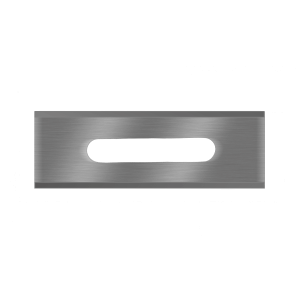 Stainless steel is a type of steel that contains at least 10.5% chromium, which gives it excellent corrosion resistance properties. Stainless steel is commonly used in applications where corrosion resistance and hygiene are important, such as the food and medical industries. It's also commonly used in industrial knives due to its excellent resistance to rust and staining.
Stainless steel is a type of steel that contains at least 10.5% chromium, which gives it excellent corrosion resistance properties. Stainless steel is commonly used in applications where corrosion resistance and hygiene are important, such as the food and medical industries. It's also commonly used in industrial knives due to its excellent resistance to rust and staining.
Here are some common types of stainless steel used in industrial knives:
- Austenitic Stainless Steel - Austenitic stainless steel is the most common type of stainless steel used in industrial knives. It's non-magnetic and contains high levels of chromium and nickel, which give it excellent corrosion resistance, high ductility, and good toughness. Examples of austenitic stainless steels commonly used in industrial knives include 304 and 316 stainless steel.
- Martensitic Stainless Steel - Martensitic stainless steel contains high levels of carbon and is heat treatable to achieve high hardness and wear resistance. It's commonly used in industrial knife applications where high strength and wear resistance are required, such as in cutting and slicing tools.
- Ferritic Stainless Steel - Ferritic stainless steel contains high levels of chromium and is magnetic. It has good corrosion resistance and is commonly used in applications where aesthetics are important, such as in kitchen utensils and appliances.
Stainless steel can be heat treated to achieve different levels of hardness and toughness, depending on the intended application. The most common heat treatment process for stainless steel is also quenching and tempering.
Industrial knives made from stainless steel offer excellent resistance to rust and staining, making them ideal for use in environments where hygiene and cleanliness are important, such as food processing and medical applications. Stainless steel knives also offer good durability and wear resistance, making them suitable for use in cutting and slicing applications. However, stainless steel knives may not hold an edge as well as high carbon steel knives, and they may be more difficult to sharpen due to their hardness.
Sollex stainless steel industrial knives you can find here
Tool Steel Industrial Knives and Blades
 Tool steels are a family of high-performance carbon and alloy steels that are designed specifically for use in cutting tools, dies, and other machine components that require high levels of hardness, wear resistance, and toughness. Tool steels are generally classified according to their chemical composition, which influences their properties and performance characteristics.
Tool steels are a family of high-performance carbon and alloy steels that are designed specifically for use in cutting tools, dies, and other machine components that require high levels of hardness, wear resistance, and toughness. Tool steels are generally classified according to their chemical composition, which influences their properties and performance characteristics.
Some common types of tool steels and their specifications include:
- Water-hardening tool steels: These steels are low-alloy steels that are capable of being hardened in water. They are typically used for cutting and forming tools that are subject to high stress and wear, and are often used in woodworking and paper cutting applications. Examples include W1 and W2 steels.
- Shock-resistant tool steels: These steels are designed to resist cracking and breaking under high stress or impact loads. They are often used for chisels, punches, and other cutting tools that are subject to high shock loads. Examples include S1, S2, and S7 steels.
- High-speed tool steels: These steels are designed to maintain their hardness and wear resistance at high temperatures, making them suitable for cutting and drilling applications that generate a lot of heat. They are often used for cutting tools that need to maintain a sharp cutting edge at high speeds. Examples include M1, M2, and M42 steels. M2 tool steel: M2 is a high-speed steel that is widely used for cutting tools and machine knives. It offers excellent wear resistance and edge retention, as well as good toughness and machinability.
- Cold-work tool steels: These steels are used for cutting and forming applications that take place at or near room temperature. They are typically used for tools that need to maintain a high level of toughness and wear resistance over long periods of use. Examples include D2 and D3 steels.
- Hot-work tool steels: These steels are used for cutting and forming applications that take place at high temperatures, such as forging and die casting. They are designed to maintain their hardness and toughness at elevated temperatures, and are often used for dies, punches, and other components that are subject to high thermal and mechanical stress. Examples include H13, H11, and H21 steels.
The specific properties and specifications of each tool steel will depend on the intended use and the manufacturing process used to produce the steel. However, common properties of tool steels include high hardness, wear resistance, and toughness, as well as the ability to maintain these properties at high temperatures or under high stress conditions.
Explore Sollex industrial knives of tool steel here.
Industrial Blades in HSS and HSS-M2
HSS (High-Speed Steel) is a type of alloy steel that is designed to withstand high temperatures and resist wear and abrasion. It is commonly used in industrial cutting tools, such as drill bits, milling cutters, and turning tools, where it is important to maintain a sharp cutting edge at high speeds and temperatures.
HSS steel typically contains high levels of carbon and other alloying elements, such as tungsten, molybdenum, and cobalt. The addition of these elements improves the steel's hardness, wear resistance, and high-temperature strength. Cobalt-alloyed high-speed steels (HSS) are used, for example, for cutting tools where high temperatures are expected. In general HSS is containing a concentration of Cobalt.
HSS steel can be manufactured in different grades and forms, including flat bars, round bars, sheets, and wire. The steel is typically heat treated to achieve specific hardness and toughness properties, with the most common heat treatment process being annealing, quenching, and tempering.
HSS steel is known for its ability to maintain a sharp cutting edge even at high speeds and temperatures, making it ideal for use in industrial cutting tools. It also has excellent wear resistance, allowing it to withstand the abrasive forces that occur during cutting operations. Additionally, HSS steel can be sharpened relatively easily, making it a popular choice for tools that require frequent sharpening.
HSS-M2 steel is often heat treated to a hardness of around 63-64 HRC (Rockwell hardness scale), which gives it excellent durability when cutting abrasive material. Overall, HSS steel is a high-performance material that offers excellent properties for cutting and machining applications. Its ability to maintain a sharp edge at high temperatures and speeds makes it an essential material in the manufacturing and metalworking industries.
Sollex HSS-M2 machine blades you can find here
D2-steel for Industrial Blades
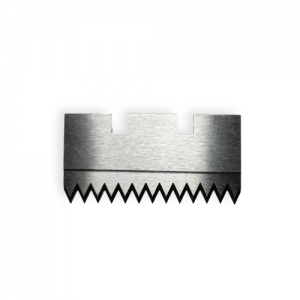 D2 steel is a high-carbon, high-chromium tool steel that is widely used in industrial applications, particularly in the production of cutting tools, knives, and dies. It is also known as "semi-stainless" steel because it contains a relatively high amount of chromium, which provides it with some corrosion resistance, but not as much as stainless steel.
D2 steel is a high-carbon, high-chromium tool steel that is widely used in industrial applications, particularly in the production of cutting tools, knives, and dies. It is also known as "semi-stainless" steel because it contains a relatively high amount of chromium, which provides it with some corrosion resistance, but not as much as stainless steel.
D2 steel is composed of approximately 1.5% carbon, 0.3% manganese, 0.6% chromium, 0.5% molybdenum, and 0.2% vanadium, with small amounts of silicon and sulfur. This composition gives D2 steel excellent wear resistance, toughness, and edge retention, making it a popular choice for industrial cutting tools and knives.
D2 steel is often heat treated to a hardness of around 58-60 HRC (Rockwell hardness scale), which gives it excellent edge retention and wear resistance. However, this also makes it more difficult to sharpen than other types of steel, and it requires a high level of skill and precision to sharpen properly.
One of the advantages of D2 steel is its ability to resist deformation and cracking during heat treatment, which makes it suitable for use in large or complex tooling applications. Additionally, its high carbon content and chromium content make it more resistant to corrosion than many other types of tool steel, although it is still susceptible to rust and staining.
Overall, D2 steel is a high-performance tool steel that offers excellent wear resistance, toughness, and edge retention. Its popularity in industrial applications is due to its ability to withstand high loads and perform well under demanding conditions, making it a valuable material for the production of cutting tools and knives.
Tungsten Carbide Industrial Blades
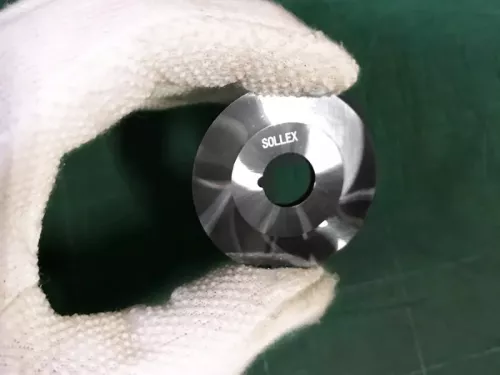 On the topic of Tungsten Carbide Tools we have prepared a series of blog posts. We start by talking about the amazing material tungsten carbide, its properties and applications in the post "Tungsten Carbide - Properties and Applications of Tungsten Carbide". You can also read the following parts about "Tungsten Carbide and Technology" and "What Kind of Tungsten Carbide Does Sollex Use" on our blog.
On the topic of Tungsten Carbide Tools we have prepared a series of blog posts. We start by talking about the amazing material tungsten carbide, its properties and applications in the post "Tungsten Carbide - Properties and Applications of Tungsten Carbide". You can also read the following parts about "Tungsten Carbide and Technology" and "What Kind of Tungsten Carbide Does Sollex Use" on our blog.
Tungsten carbide is not actually a type of steel, but rather a composite material that consists of tungsten carbide particles held together by a metal binder. Tungsten carbide is known for its exceptional hardness and wear resistance, making it a popular choice for a wide range of industrial applications.
The tungsten carbide particles in the composite material are typically made by reacting tungsten powder with carbon at high temperatures, resulting in the formation of tungsten carbide particles. These particles are then mixed with a metal binder, such as cobalt or nickel, and compressed under high pressure to form the final tungsten carbide product. Tungsten carbide contains aproximately 10% Cobalt.
The metal binder in tungsten carbide helps to hold the tungsten carbide particles together, providing the material with toughness and impact resistance. The exact composition of tungsten carbide can vary depending on the application, but typical compositions include between 70% and 97% tungsten carbide by weight, with the remainder being the metal binder.
Machine knives made of tungsten carbide are highly valued in the manufacturing industry for their exceptional hardness and wear resistance. Tungsten carbide is a composite material made of tungsten and carbon, which is sintered under high pressure and temperature to create a hard and dense material.
The use of tungsten carbide in machine knives provides several advantages over other materials, such as carbon steel or stainless steel. Tungsten carbide is much harder than steel, making it more resistant to wear, deformation, and damage. This allows machine knives made of tungsten carbide to maintain their sharpness and cutting performance for longer periods of time, which reduces downtime and maintenance costs.
Tungsten carbide industrial knives and blades are commonly used in industrial cutting and slicing applications, such as in the paper, textile, and food processing industries. They are also used in metalworking applications, such as in the production of slitting and shearing tools.
Tungsten carbide is a composite material made of tungsten and carbon, and it typically has the following specifications:
- Hardness: Tungsten carbide is one of the hardest materials known, with a hardness range of 87-94 on the Rockwell A hardness scale (HRA), or 1500-2400 Vickers hardness (HV).
- Density: Tungsten carbide has a density of 14.5-15.9 g/cm3, which is much higher than that of steel. This high density gives tungsten carbide its exceptional hardness and wear resistance.
- Strength: Tungsten carbide has high compressive strength, with values typically in the range of 2000-4000 MPa. This makes it highly resistant to deformation and damage under high loads.
- Toughness: While tungsten carbide is very hard and wear-resistant, it is also somewhat brittle, which can make it prone to cracking and chipping. However, various techniques can be used to improve its toughness and resistance to fracture.
- Thermal conductivity: Tungsten carbide has relatively low thermal conductivity compared to other metals and alloys, which can make it prone to overheating and thermal damage during cutting operations.
- Corrosion resistance: Tungsten carbide is highly resistant to corrosion, although it can be susceptible to some types of chemical attack, particularly by acids.
- Electrical conductivity: Tungsten carbide is a poor electrical conductor due to its high resistance to electron flow.
Its unique properties make it an ideal material for use in a wide range of industrial applications, particularly in cutting and machining tools, wear parts, and abrasives.
One of the challenges in using tungsten carbide machine knives is their brittleness, which makes them more prone to chipping and cracking than steel knives. To address this, tungsten carbide machine knives are often designed with a thicker cross-section, which provides additional support and helps to prevent damage during use.
Overall, machine knives made of tungsten carbide are a high-performance solution for cutting and slicing applications that require exceptional hardness and wear resistance. While they can be more expensive than other materials, their long service life and improved performance make them a valuable investment for many industrial applications.
Sollex industrial knives and blades of tungsten carbide
Bi-Metal Machine Knives
Bimetal material is not a specific type of steel, but rather a composite material made up of two different metal layers that have been bonded together. The two metal layers in a bimetal material can be made of different types of steel or other metals, depending on the specific application and the desired properties of the material.
One common type of bimetal material is a steel-backed composite material that is used in the production of bearings, bushings, and other components. In this type of bimetal material, a layer of low-carbon steel is bonded to a layer of high-lead bronze or other bearing alloy. The low-carbon steel layer provides the material with strength and toughness, while the bearing alloy layer provides the material with low-friction and high-wear resistance properties.
Bimetal materials are commonly used for the production of cutting tools and machine knives. In fact, bimetal construction is often the preferred method for manufacturing high-performance cutting tools that require both strength and wear resistance.
For example, bimetal blades and saws are widely used in the metalworking industry for cutting hard and abrasive materials, such as steel, aluminum, and titanium. Bimetal construction allows for a strong, durable backing material that supports a thin layer of high-speed steel or tungsten carbide, which provides the sharp cutting edge.
Bimetal knives are also commonly used in the food processing industry, where they are used to cut and slice a variety of foods, including meat, cheese, and bread. The bimetal construction allows for a blade that is both sharp and durable, with a cutting edge that resists dulling and wear over time.
Overall, bimetal materials are a popular choice for cutting tools and machine knives because they offer a combination of strength, wear resistance, and sharpness that is difficult to achieve with a single material. By bonding two different metals together, manufacturers can create a material that is specifically tailored to the needs of a particular application, providing a high-performance tool that delivers consistent results over time.
What should I consider when choosing the steel grade for industrial blades?
When choosing the right machine knife for a particular application, it is important to consider the specific properties of the steel material being used. Here are some important factors to consider when evaluating steel materials for machine knives:
- Hardness: The hardness of the steel will determine how well it will hold an edge and resist wear over time. Harder steels, such as high-speed steels and tungsten carbide, are typically preferred for applications that require high cutting speeds and/or heavy use.
- Toughness: The toughness of the steel will determine how well it can withstand impact and shock loads. Steels that are too hard may be brittle and prone to chipping or breaking, while steels that are too soft may not hold up well under heavy use.
- Corrosion resistance: Depending on the application, the steel material may need to be resistant to corrosion from exposure to moisture, chemicals, or other substances. Stainless steels are often preferred for applications that require good corrosion resistance.
- Machinability: Some steel materials are easier to machine and work with than others, which can be an important factor to consider when manufacturing custom machine knives.
- Cost: The cost of the steel material will also be a factor to consider, as some high-performance steels may be more expensive than others.
It is important to consider both the machine knife material and the material to be cut when making optimal tools for a particular applications.
The cutting web material or material to be cut will often determine the specific requirements for the knife itself. For example, if the cutting web material is a hard and abrasive material like stainless steel or titanium, then a machine knife made from a high-speed steel or tungsten carbide may be required to provide the necessary wear resistance and edge retention.
On the other hand, if the cutting web material is a softer material like plastic or rubber, then a machine knife made from a lower hardness steel may be sufficient. However, it is still important to consider other factors such as toughness and corrosion resistance, as well as the specific requirements of the cutting process itself.
Overall, the choice of machine knife material and cutting web material will be interrelated, as the properties of each will have an impact on the performance and durability of the other. By considering both factors together, it is possible to select a machine knife that will provide optimal performance for a particular cutting application.
About Sollex Knives and Blades

Our machine knives and industrial-type razor blades are made of high quality stainless steel with different coatings on the edge or side of the blades. Sollex makes blades in solid tungsten carbide or ceramics. If you do not find the blade you are looking for, Sollex are able to manufacture industrial knives and razor blades according to your drawing or needs. Feel free to contact us at +4635-15 75-00 or at info@sollex.se if you have any questions regarding our industrial razor blades.

